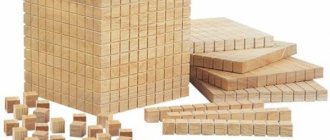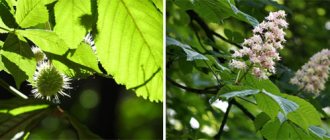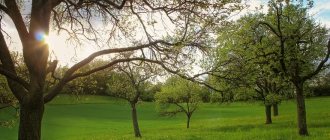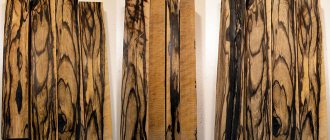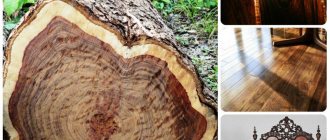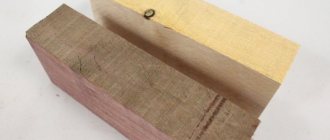- November 29, 2018
- Trees and shrubs
- Rezeda Zaripova
Even at the dawn of mankind, chestnut trees grew almost everywhere, including Greenland. For more than five centuries it has been grown in Europe as an ornamental tree. They learned about its medicinal properties much later.
This amazing deciduous tree, which has a beautiful dense crown, does not require any special conditions for growing, and caring for it will not be difficult.
You can find out what a chestnut tree looks like and what the features of its cultivation are by reading the information presented in the article.
general information
When growing all varieties of chestnut, you need to have some patience because they do not grow very quickly. But with careful and proper care, after about 10 years, having outstripped neighboring garden trees in growth, it can become an excellent protection against the sweltering heat in the summer thanks to its thick and lacy foliage. And if necessary, it can also be used as a healer for many ailments.
The umbrella-like high crown of the chestnut tree provides good shade, and the surprisingly delicate flower candles of the chestnut tree delight with their beauty and freshness every spring for a couple of weeks. In the wild, this plant grows in many southern countries, but they can often be found as a garden and ornamental crop in the middle zone. Planting and care procedures are not as complicated and expensive as it may seem to beginners. The main thing is to be patient and do everything right.
There are approximately 15 species of this plant around the world. The flowering period depends on the type of plant. The most common species in Russia are noble and horse chestnut, which bloom in early May. Chestnut is an excellent honey plant.
What is rich in the autumn chestnut leaf?
Chestnut leaves contain vitamins B and C, but these are not all the substances they contain. Scientists have identified several complex triterpene compounds that help improve metabolism. Tannins contained in chestnut leaves have a general strengthening and antiseptic effect. Pectins remove toxins and other breakdown products from the body. Also, the autumn chestnut leaf contains flavonoids. Flavonoids are substances that stimulate the synthesis of natural enzymes. In addition, the foliage contains glucose, lecithin, organic substances, trace elements and vitamins.
Attention!
For medicinal purposes, healers use the leaves of the seed chestnut.
Foliage of other varieties may not be suitable for medicinal use. Cultivated chestnut is common in many regions of Russia. It is distinguished by the appearance of its foliage. It has an oblong shape and is slightly pointed at the ends. The foliage length of seed chestnut is about 25 cm.
The collection of chestnut leaves for medicinal use begins in August and ends at the end of September. The material should be evenly laid out on a cloth to dry. During the first days of drying, the leaves need to be turned over so that they dry evenly. Dried leaves are placed in dry containers and used throughout the year.
READ Another mountain pine - Mugus
Types and varieties of chestnut
The most popular and widespread representative of the plant in Russia is horse chestnut. A mature chestnut tree of this variety grows up to 30 meters in height. It has large, palmate, compound leaves with clearly defined veins. Racemose inflorescences with double white, pink and yellow flowers appear in May. There are red spots in the very center.
There are other types of chestnut:
- Californian, grows in the western United States and has a height of up to 10 meters, as well as flowers of a white and pink hue.
- Red is a Crimean variety that grows up to 30 meters in height and has large racemose inflorescences of a dark red hue.
- Yellow is a tree with a pyramidal crown, serrated golden leaves and yellow inflorescences, and is an eastern American variety.
- Small-flowered chestnut, which is a shrubby form (up to 5 meters in height) with small compound leaves, colored grayish on the underside.
- Red chestnut, or pavia, is a tree or shrub (up to 10 meters in height) with bright red flowers that grows in the eastern United States.
- Japanese is an upright tree with large leaves, yellow-white flowers and pear-shaped fruits.
Description of the tree
Light-loving trees begin flowering in early May and have the following characteristics.
Leaves
Chestnut trees have an opposite appearance with 5-7 leaves, the average length of which is approximately 20 centimeters. The color of the leaves is rich green. They have a pointed shape towards the ends.
Flowers
Unlike other trees, chestnuts have beautiful large large flowers with a diameter of about 2 centimeters. The flower itself is presented in a beautiful white-pink shade, it is collected in extraordinary small inflorescences, presented on all branches. The trees begin to bloom in early May and continue until summer, approximately 25 days. Many people associate blooming chestnut trees with candles. The branches are positioned straight up.
Fruit
The fruit has an interesting shape in the form of a ball with spines, the average diameter is 6 centimeters. Inside the casing there is a sweet chestnut fruit of a light brown hue. There are 2 to 3 pieces inside. In most countries, the fruits are highly valued and have a high price as a delicacy.
Description
The chestnut tree can decorate any country house or garden. This is a large deciduous plant belonging to the Beech family. Its height can reach 25 meters.
The straight, slender trunk, brownish-gray in color, can be up to one meter in diameter. The chestnut's fairly powerful root system with a main taproot has very branched lateral roots, making the tree resistant to gusts of wind.
Chestnut leaves are large and compound, five- or seven-fingered, with a long spine. In summer, the leaves are green, and in autumn they turn yellowish, brown, purple and crimson. Chestnut greens contain tannins, vitamin K and pectin. It is often used in the preparation of decoctions and tinctures used for various ailments.
The crown of the tree, thanks to the large openwork leaves, is wide and very dense. It has a round shape.
Application and meaning
Chestnut wood is similar to oak in its structure and texture, but it is less durable. Processing such wood does not cause difficulties, for example: splitting, tinting, impregnation with a protective compound or gluing. Finished products are able to retain their shape and are not subject to rot. This wood is used:
- for finishing buildings;
- for the manufacture of designer furniture;
- in shipbuilding;
- for the production of barrels.
Not long ago, chestnut trunks were used to make telegraph poles. But since 2012, the Russian Agricultural Agency issued an order prohibiting the logging of Castanea sativa wood.
Delicious nuts are nutritious; they contain large amounts of tannins, proteins, carbohydrates and vitamins. They are also rich in magnesium, potassium and phosphorus. Up to 1 ton of nuts are collected from 1 hectare.
Chestnut is also a valuable honey plant. Honey has a bitter taste, but is very healthy and is very popular. In alternative medicine, the bark is used, which contains many tannins.
Fruit
The fruits of the chestnut tree are round green boxes (nuts) with opening flaps that are covered with sharp thorns. Each nut contains from one to four seeds. The plant begins to bear fruit only from 15-25 years of age.
Real (noble) chestnut nuts can be used in cooking. Horse chestnut is mainly used in landscaping. The latter is quite winter-hardy, but it does not tolerate long periods of drought.
Benefits and harms of fruits
Chestnut fruits are useful for hypovitaminosis, physical exhaustion, disturbances in psycho-emotional balance, surges in blood pressure, reduced immunity, and a tendency to inflammatory diseases. It is a source of vegetable protein, fatty acids, complex carbohydrates and biologically active substances. In terms of vitamin and mineral composition, chestnuts are comparable to other types of nuts.
You should avoid eating chestnuts if:
- overweight or obesity;
- diabetes mellitus;
- peptic ulcer of the stomach or intestines.
A large amount of starch in the kernels can aggravate existing carbohydrate metabolism disorders, and coarse fiber can cause exacerbation of gastrointestinal pathologies.
Features of flowering
During flowering, chestnuts look very beautiful. Large fragrant inflorescences look like candles, evenly scattered throughout the crown. Spike-shaped, pyramidal inflorescences (length - 10-35 centimeters) are located vertically on the tree. Their lower part is female flowers, the upper part is male.
Each flower has a 5-8-membered perianth. The flowers, depending on the variety of chestnut, can be white, pink or red.
What it looks like: description of the appearance of plant parts: fruits, leaves, flowers
Which you can eat
The tree, 25-30 m high, has a dense spreading crown and an even trunk with a diameter of 1-2 m, covered with cracked grayish-brown bark. Lanceolate leaves of a dark green color with a leathery leaf blade and jagged edges are arranged sequentially, one after the other. Their length is 10-28 cm and width - 5-9 cm. With the onset of autumn, the leaves become bright yellow.
When the time for flowering comes, the tree is covered with earring-like narrow and long spike-shaped inflorescences (no more than 1 cm wide and 10 to 35 cm long) with small white or beige flowers.
Female flowers are located at the base of the inflorescences, and male ones are located at the top, but there are inflorescences with only male flowers. Cross-pollination is carried out under the influence of wind, as well as with the help of insects.
Dark brown seeds (nuts) with a smooth surface, a characteristic “tail” and a small rough light spot, covered with a leathery amniotic membrane and enclosed in brown spherical fruits (pluses) dotted with thin dense spines, which open into 4 segments when ripe. As a rule, each seedling contains 3 nuts , but this number can vary from 1 to 7.
Reference
The pulp of the nuts is soft, starchy, with a sweetish, pleasant taste.
Edible chestnut tree:
Edible chestnut flowering:
Edible chestnut fruits:
Which you can't eat
The height of the tree with a smooth, wrinkled trunk of dark gray color and a dense dome-shaped crown does not exceed 15 m. Each leaf, dark green in color and fan-shaped, complex palmate, consists of 5-7 individual leaflets located on one petiole. The leaves reach up to 60 cm in diameter.
Reference
Erect paniculate inflorescences, large and lush, appear in May. They look like candles and have a pyramidal shape.
The length of the panicle is from 10 to 30 cm. Each inflorescence consists of 20-50 bell-shaped flowers with a diameter of 2 cm, having a white, creamy yellow or pink color. After pollination, reddish specks appear on them.
The glossy seeds are round in shape and dark brown in color, with a rough whitish spot , located in large seed pods of bright light green color, covered with a small number of short spines and opening into 3 segments when ripe. Usually there is one seed in a copper, less often - two. The fruits ripen from August to September.
Inedible chestnut tree:
Paniculate inflorescences of inedible chestnut:
Inedible chestnut fruits:
Growing conditions
How to grow a chestnut and what conditions does it need for this? When deciding to plant this plant in the garden, you should take into account that for its normal development you need space. It should be planted so that there are no buildings or plantings within a radius of 5 meters from it. Even grass cannot grow under its thick crown.
Despite the fact that chestnut is of southern origin, it is quite winter-hardy. Some specimens, under the most favorable growing conditions, live more than a hundred years. Due to the presence of a fairly powerful and branched root system, the tree can grow in harsh climates, while needing shelter for the winter only at a young age. In summer, this plant can withstand heat of 30 degrees, but the best temperature for it is + 20...25 ⁰C. With thick snow cover in winter, the chestnut tree can withstand twenty-degree frosts, but suffers from piercing and cold winds.
Does not tolerate chestnut and polluted atmosphere well. Therefore, on the streets of cities with a large number of industrial enterprises one can often observe the fading foliage of these trees in the hot summer.
How to grow an edible chestnut from a fruit. Edible chestnut - how to grow delicious exotics yourself.
Hello, readers of the channel “Country Stories”
Today, we will talk about an amazing plant - edible chestnut (real). This is the same chestnut that people like to roast in the southern regions, the same chestnut with which autumn Paris is associated.
Despite the fact that the recommended place for growing edible chestnut is, it is possible to grow this beautiful tree in central Russia.
The selection of edible chestnuts was deliberately carried out in Japan and the USA.
The chestnut shows itself at its best as a hardy, unpretentious plant. Which begins to bear fruit at the age of 4-5 years.
Moreover, you can propagate chestnuts with your own chestnuts; you don’t need to graft anything, as it doesn’t lose its qualities. Ten-year-old trees grown from chestnuts are already bearing fruit in full.
The chestnut is edible and has been growing beautifully in my garden for about 20 years. And I can recommend it to all summer residents for planting.
In twenty years, the tree has grown to approximately 6 meters. If you have several seedlings, you can plant them in one hole; they will grow beautifully as a bush, like chokeberry.
The ripening time for edible chestnuts in the middle zone occurs in mid-October. The chestnuts themselves grow in a shell that resembles a hedgehog. In each such “hedgehog”, from 3 to 7 chestnuts ripen, which are similar to the wild chestnuts that we are used to seeing.
Gardeners who grow chestnuts try to remove hedgehogs at the stage of the first cracks, in order not to share the harvest with birds and rodents.
With age, the chestnut's tolerance to unfavorable external conditions increases. If, for example, some of the tops freeze, they will recover perfectly in the next season; the chestnut tree can even grow back completely from the root.
Despite the threat of frost in winter, it is necessary to cover the edible chestnut only in the first two or three years, then this cannot be done, it is necessary for the chestnut to acclimatize itself.
Edible chestnut can be distinguished from horse (wild) chestnut, primarily by its leaves. And it should be recalled that these are completely different plants, from different families.
The fruits of the edible chestnut are very tasty and sweet.
I can say with full responsibility that the most delicious is a raw chestnut - straight from the branch. Baked or dried, which you can buy in a store - not the same!
If you try to describe the taste, it is something very sweet between sunflower seeds and hazelnuts.
I recommend planting a real chestnut tree on your property. Then say thank you.
Preparing for landing
Planting this plant is not difficult, but it is always necessary to take into account the condition of the soil. The planting site should be pre-prepared if the soil composition is unfavorable for this tree. You need to dig a hole, fill it with a mixture of turf soil (three parts), humus (two parts) and sand (one part).
The best period for planting chestnuts is autumn or early spring. These dates should not be shifted, as there is a possibility that the seedling will not have enough time to take root.
Excellent planting material is three-year-old and older specimens.
What does a garden chestnut look like?
The spectacle is truly amazing. The description of the chestnut tree says that it is a deciduous ornamental specimen from the Beech family. There are many types, for example, red chestnut. Able to reproduce using nuts. The height can exceed 50 m. The trunk can be up to 2 m in diameter. The length of the leaf blades is about 20 cm, and its flowers are up to 15 cm. The wood is painted dark brown. The leaves themselves are oval in shape. Like many trees, they are green in the summer and turn yellow in the fall.
When the chestnut tree blooms
What is striking about the chestnut tree is its flowers. They are collected in inflorescences. These are staminate flowers. Pistillates are found only at the base of the inflorescence. The chestnut begins to bear fruit only 15 years after it is planted, but a cultivated one does this 10 years later. For the first 5 years the tree grows quite slowly, but after this period of time the process accelerates. The fruits fully ripen every 2-3 years. This is September and October.
Where does it grow
Although it is quite resistant to frost, it still loves warmth. It prefers the climate of the Middle Zone, as well as moist (and slightly acidic) soil. But it cannot tolerate extreme heat either.
Chestnut grows in different places: American on the Atlantic coast of the USA, in the Balkans, the Mediterranean coast, in East Asia, Russia (in Crimea and Transcaucasia). In Europe, the fruit can grow to the size of a whole tangerine. But in Azerbaijan or Armenia they often reach a small size, no larger than a walnut. How quickly chestnut grows will be discussed below.
Work order
- Dig a hole more than 0.5 meters wide and deep.
- Add humus and one glass of superphosphate to the soil (add dolomite flour to neutralize excessive acidity).
- For drainage, cover the bottom of the pit with a layer (15 cm) of sand and fine crushed stone.
- When planting the plant, the root collar should remain at ground level.
- Make a small mound around the trunk to prevent subsidence of the root neck.
- Watering should be done with about three to four buckets of warm water, and then, after planting, watering should be done daily.
- For better rooting, the seedling should be tied to a support, which can be removed after the chestnut is completely rooted.
How to plant a chestnut tree and grow a beautiful tree?
When choosing soil for planting chestnuts, this type of tree is very whimsical, so it is necessary to take this point into account when decorating summer cottages. Loose and fertile soil is best suited; chernozem or loam with a high lime content is considered the best option. Planting must be done at a distance of 5 meters from each other.
The instructions and procedure for planting decorative chestnuts are as follows:
- It is first necessary to prepare a hole for planting 15-20 centimeters larger than the dimensions of the seedling;
- The sprout is placed in a hole and then covered with soil mixed with humus in a 2:1 ratio;
- The bottom of the pit must be drained using pebbles or gravel, the thickness of the cushion should be approximately 150 mm;
- After filling and compacting the soil, manual watering is carried out;
- During the first year, seedlings must be secured to supports for good growth.
Planting seeds and seedlings
Chestnuts are planted using sprouted nuts; they are planted in the ground to a depth of at least 2 centimeters. Due to deep planting, sprouts can make their way to the top very slowly. If the nuts are planted in sandy soil, it is diluted with clay.
Choosing nuts for planting
It is important to correctly determine the nut that is suitable for planting and further growing chestnuts, so it is better to contact specialists. The fruits should not only have a beautiful and even appearance, but there should also be no damage to the nut.
Care
Caring for a chestnut tree is easy. A young tree should be constantly taken care of, but a mature plant practically does not need care.
It is undesirable to leave a young tree in direct sunlight, as it can get quite severe burns from overheating. In the first year of plant growth, it should be watered intensively and protected from hot sunlight.
Agrotechnical measures after planting:
- Watering. It should be constant for young specimens, and mature ones should be watered as needed. It is better to use settled water for this. The plant should be watered either early in the morning or before sunset.
- Weeding. It should be done only at first, because subsequently the dense overgrown crown of the tree does not allow foreign vegetation to grow in the tree trunk area.
- Mulching. To maintain looseness around the chestnut, it is necessary to mulch the soil with a 10-centimeter layer of peat or wood chips with the addition of compost.
- Feeding. This is a mandatory ritual for good plant growth. After wintering, you can feed with manure and urea, ammonium nitrate and phosphorus-potassium fertilizers. In autumn, chestnut can be fertilized with nitroammophoska.
- Preparing for the winter period. It is needed only in the first years after planting. To do this, the tree trunk should be wrapped in several layers of burlap, and the tree trunk circle should be mulched. These measures help prevent cracking of the bark in frost.
- Trimming. This is necessary for the formation of a lush, beautiful crown. During spring pruning, regrown shoots of young trees should be shortened by half. Thin branches should be removed in summer to avoid excessive growth of the crown. In this case, be sure to leave about five strong side shoots intact. The cut areas must be covered with garden varnish.
Planting
In order to plant a chestnut tree correctly, it is important to remember that it loves space, as it spreads its branches widely, and its roots underground also spread far from the trunk. Therefore, it is recommended to plant chestnuts 7–10 meters from fences and other buildings
It should also be remembered that under the dense crown of an adult chestnut a dense shadow is formed, which often does not allow even grass to grow at the foot of the tree. Therefore, if you decide to plant a chestnut tree in your garden, then prepare more space for it and do not forget that it loves light. Find a place where it will be lit from all sides. By the way, under the branches of a tree you can perfectly place, for example, benches or a children's swing. Then the foot of your tree will eventually become an ideal place for relaxation and children's entertainment during the hot summer.
Methods for planting chestnut trees.
Before you begin one of the important things that a person should do in this life, namely: plant a tree, you need to decide in what way you will do this. You also need to have a clear understanding of the characteristics of the tree and the intricacies of its planting and cultivation. Since chestnuts are still heat-loving plants, regions with a moderate, not hot, climate and a humidity of at least 70% are most suitable for growing them.
Methods of propagation of chestnut.
There are two traditional methods of propagating chestnuts. One of them is the vegetative method. Simply put, propagation by layering, cuttings or using root shoots.
Another method of growing using seeds, due to its simplicity, has found the greatest popularity among lovers of ornamental plants. It is just right for those who intend to grow a tree at home. We’ll talk about this method in more detail.
No special knowledge is required to use the seed method. The main thing is to pick up already fallen and well-ripened fruits - nuts.
Germination of seeds.
Seeds need to go through a stratification process, in other words, simply kept for a long time at the right temperature. Although, in the fall, you can immediately plant the seeds in open ground, previously saturated with crushed leaves that have fallen from trees. Scientifically, this procedure is called mulching. Having planted in this way in the fall, next spring you can watch your seeds sprout small sprouts that will soon reach for the sun. The only problem with the seed growing method is rodents. In winter, due to insufficient food, they can simply devour the seeds or spoil them, preventing them from hatching.
When planting chestnuts in spring, the stratification procedure, which is mentioned just above, is mandatory. To do this, the seeds are first placed in a cool place in moist soil for several months (usually from two to five). Immediately before planting the seeds in open ground, they must be soaked in water at room temperature for a short time. Thus, the water will soften their coat of thin skin, and then the sprouts will look out from their temporary “shelters” much faster.
The next step is to plant the babies in the garden bed for further germination. The depth of planting small shoots is 8–10 centimeters, with a distance from each other of about 20 cm. Young shoots must be constantly looked after, weeded, loosened and watered if necessary.
Planting seedlings in a permanent place
After a year, you can thin out the seedlings, again, if the situation requires it. It is recommended to place young chestnut shoots at a permanent planting site no earlier than the third year in southern latitudes. In moderate in the fifth year. In this case, one should take into account the features that we have already mentioned above. Namely, do not save space for trees, because firstly, they themselves love space, and secondly, when the seedlings grow and turn into adult trees, they will need many times more space than when they were initially planted.
Diseases and pests
The chestnut tree sometimes suffers from certain diseases (fungi), invasion of beetles and other pests. A damaged tree with reddened leaves must be urgently sprayed with Bordeaux mixture or Fundazol.
Mites are also dangerous for chestnuts. To prevent its appearance, you need to treat the tree with Fitoverm or Karbofos 2 times a month. The most effective folk remedies are decoctions of dissected hogweed and black henbane.
In recent years, previously unknown Balkan or chestnut moths have begun to attack chestnut trees. From them, in the summer, chestnut leaves fall off after drying out, and by autumn they bloom again. Further, late flowering occurs, and therefore the plant meets the winter unprepared. The latter leads to freezing and even death of the plant. These pests are difficult to control. An effective measure is the timely removal of damaged fallen leaves, among which numerous pupae of this moth overwinter.
Diseases and pests of the horse chestnut tree: dries and turns yellow
Until recently, the chestnut tree’s low susceptibility to diseases and pests was considered one of the undoubted advantages of the crop. Indeed, only occasionally did spotting appear on the leaves, indicating the presence of fungal diseases, powdery mildew or anthracnose; sometimes the tree was attacked by borers, bagworms, and Japanese beetles. To combat horse chestnut diseases, it was enough to carry out several sprays with Bordeaux mixture or fungazol; the pests could be destroyed using karbofos or any other insecticide. However, recently the plant's population in Europe has been attacked by a new little-studied insect called the chestnut moth, balkan moth, or leaf miner. Its origin is still unknown; this small pest was first discovered in 1985 in Macedonia, after which it quickly spread throughout the continent. The natural enemies of the leafminer moth are still unknown to science, control measures have been little studied, and the damage it causes to trees is very significant.
The leaves of affected chestnuts dry out and fall off in mid-summer, and young foliage and flowers appear in the fall. Such plants go into winter weakened and often freeze out. To destroy this dangerous chestnut pest, special chemicals are used, which are injected directly into the trunk. Another protective measure is the autumn harvesting of leaves in which Balkan moth pupae overwinter. If carried out carefully, the degree of damage to plantings can be significantly reduced.
Note that chestnuts turn yellow not only under the influence of diseases or pests. Prolonged drought and strong winds also lead to burning of leaves, which as a result curl, dry out and fall off. Trees especially often suffer from heat and dry winds in the steppe climate of southern Russia, which must be taken into account when organizing crop care in these regions.
When and how is it collected?
The fruits of an edible plant ripen 15-20 years after planting , and for horse chestnut this happens after 10-15 years.
For consumption
The noble chestnut harvest, depending on the variety, is carried out from October to November:
- the ground under the tree is cleared of leaves and branches;
- covered with tarpaulin or non-woven material;
- knock down nuts using long poles;
- cleared of thorny seed pods;
- Damaged fruits are discarded, and good ones are placed in baskets or cloth bags;
- dry in a shaded and well-ventilated place.
Not edible
Horse chestnut fruits are harvested in August-September , when they begin to fall from the tree:
- the area under the crown is pre-cleaned and covered with non-woven material;
- the fruits are peeled and placed in boxes or bags;
- dry under a canopy or in a room with good ventilation at temperatures up to +25 ° C.
Advice
The leaves are harvested from May to September, before they begin to turn yellow, and dried in the air under a canopy, spread out in a layer of 2-3 cm. The flowers are collected in May and dried first in the sun (1 day), and then in a ventilated room . Chestnut bark is collected in the spring, cut into pieces and dried in the open air.
Description of chestnut
Chestnuts are large trees with a wide spreading crown. Their height can reach 40 m. The trunk, up to 2 m in girth, is covered with furrowed bark. The branches have a reddish-brown tint. They grow rich green oblong foliage 8-25 cm long. Leathery leaf blades are pointed towards the top. The root system includes several large roots, which provide the tree with good stability, but their depth is not too high. Because of this feature, chestnuts are sometimes planted above cellars. Such plants are considered long-lived and in natural conditions can live more than 500 years, although the average age of trees in forests reaches 100 years.
Chestnut flowering begins in May. During this period, erect inflorescences-spikelets appear on it, consisting of many small flowers, hardly noticeable among the foliage. During the flowering period, you can especially quickly distinguish a real chestnut from a horse chestnut. The latter has larger and more spectacular white-pink inflorescences that exude a pleasant aroma. There are other differences in plants - for example, the foliage of horse chestnut has a finger-like structure and jagged edges. Edible chestnuts have smooth leaf edges.
Chestnut flowers are pollinated by insects or wind. After this, glossy fruits and nuts are formed on the plant. They are located in a special spherical plus, characteristic of beech representatives. The plus is colored green, covered with many hard needles and opens after the fruit has fully ripened. The Latin name of the plant, Castanea, is associated precisely with the structure of its fruits and refers to the myth of the chaste nymph Ney, who did not succumb to the courtship of Jupiter. The nuts themselves are brown in color and are considered edible by most species. In many countries they are used for baking bread and preparing other dishes.
The fruits of the chestnut seed plant can also be eaten after certain processing, but horse chestnut seeds are considered inedible, despite their great similarity to ordinary chestnuts. They have a bitter taste, and their consumption can lead to severe poisoning. The shell of such “chestnuts” has sparser spines and is also colored green. But, despite the inedibility of the seeds, horse chestnut is also considered a good honey plant.
EDIBLE CHESTNUT - delicious exotic in the garden! It will grow on you too!
